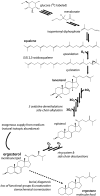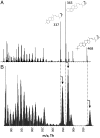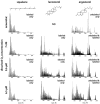Microaerobic steroid biosynthesis and the molecular fossil record of Archean life
- PMID: 21825157
- PMCID: PMC3158215
- DOI: 10.1073/pnas.1104160108
Microaerobic steroid biosynthesis and the molecular fossil record of Archean life
Abstract
The power of molecular oxygen to drive many crucial biogeochemical processes, from cellular respiration to rock weathering, makes reconstructing the history of its production and accumulation a first-order question for understanding Earth's evolution. Among the various geochemical proxies for the presence of O(2) in the environment, molecular fossils offer a unique record of O(2) where it was first produced and consumed by biology: in sunlit aquatic habitats. As steroid biosynthesis requires molecular oxygen, fossil steranes have been used to draw inferences about aerobiosis in the early Precambrian. However, better quantitative constraints on the O(2) requirement of this biochemistry would clarify the implications of these molecular fossils for environmental conditions at the time of their production. Here we demonstrate that steroid biosynthesis is a microaerobic process, enabled by dissolved O(2) concentrations in the nanomolar range. We present evidence that microaerobic marine environments (where steroid biosynthesis was possible) could have been widespread and persistent for long periods of time prior to the earliest geologic and isotopic evidence for atmospheric O(2). In the late Archean, molecular oxygen likely cycled as a biogenic trace gas, much as compounds such as dimethylsulfide do today.
Conflict of interest statement
The authors declare no conflict of interest.
Figures




Similar articles
-
The role of biology in planetary evolution: cyanobacterial primary production in low-oxygen Proterozoic oceans.Environ Microbiol. 2016 Feb;18(2):325-40. doi: 10.1111/1462-2920.13118. Epub 2015 Dec 21. Environ Microbiol. 2016. PMID: 26549614 Free PMC article. Review.
-
Co-evolution of early Earth environments and microbial life.Nat Rev Microbiol. 2024 Sep;22(9):572-586. doi: 10.1038/s41579-024-01044-y. Epub 2024 May 29. Nat Rev Microbiol. 2024. PMID: 38811839 Review.
-
The evolution and distribution of life in the Precambrian eon-global perspective and the Indian record.J Biosci. 2009 Nov;34(5):765-76. doi: 10.1007/s12038-009-0065-8. J Biosci. 2009. PMID: 20009270 Review.
-
The paleobiological record of photosynthesis.Photosynth Res. 2011 Jan;107(1):87-101. doi: 10.1007/s11120-010-9577-1. Epub 2010 Jul 7. Photosynth Res. 2011. PMID: 20607406 Free PMC article. Review.
-
Petrographic carbon in ancient sediments constrains Proterozoic Era atmospheric oxygen levels.Proc Natl Acad Sci U S A. 2021 Jun 8;118(23):e2101544118. doi: 10.1073/pnas.2101544118. Proc Natl Acad Sci U S A. 2021. PMID: 34074783 Free PMC article.
Cited by
-
The photo-protective role of vitamin D in the microalga Emiliania huxleyi.iScience. 2024 May 6;27(6):109884. doi: 10.1016/j.isci.2024.109884. eCollection 2024 Jun 21. iScience. 2024. PMID: 38799580 Free PMC article.
-
Tryptophan extends the life of cytochrome P450.Proc Natl Acad Sci U S A. 2023 Dec 12;120(50):e2317372120. doi: 10.1073/pnas.2317372120. Epub 2023 Dec 7. Proc Natl Acad Sci U S A. 2023. PMID: 38060561 Free PMC article.
-
Circulating androgen regulation by androgen-catabolizing gut bacteria in male mouse gut.Gut Microbes. 2023 Jan-Dec;15(1):2183685. doi: 10.1080/19490976.2023.2183685. Gut Microbes. 2023. PMID: 36843073 Free PMC article.
-
Influence of ergosterol and phytosterols on wine alcoholic fermentation with Saccharomyces cerevisiae strains.Front Microbiol. 2022 Sep 8;13:966245. doi: 10.3389/fmicb.2022.966245. eCollection 2022. Front Microbiol. 2022. PMID: 36160262 Free PMC article.
-
Innovation and tinkering in the evolution of oxidases.Protein Sci. 2022 May;31(5):e4310. doi: 10.1002/pro.4310. Protein Sci. 2022. PMID: 35481655 Free PMC article. Review.
References
-
- Allen JF, Martin W. Evolutionary biology: Out of thin air. Nature. 2007;445:610–612. - PubMed
-
- Allen JP, Williams JC. The evolutionary pathway from anoxygenic to oxygenic photosynthesis examined by comparison of the properties of photosystem II and bacterial reaction centers. Photosyn Res. 2011;107:59–69. - PubMed
-
- Rye R, Holland H. Paleosols and the evolution of atmospheric oxygen; a critical review. Am J Sci. 1998;298:621–672. - PubMed
Publication types
MeSH terms
Substances
Grants and funding
LinkOut - more resources
Full Text Sources
Research Materials


